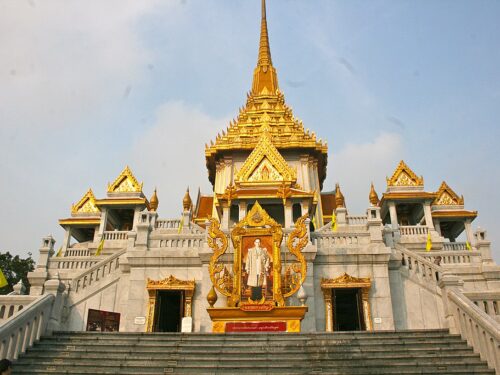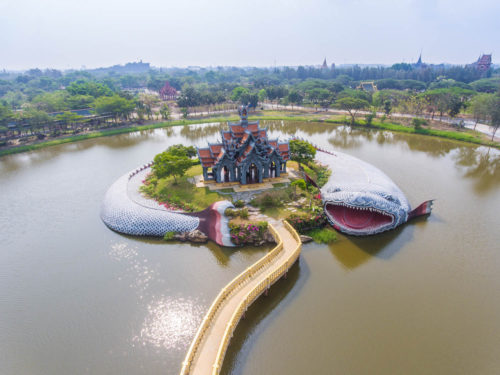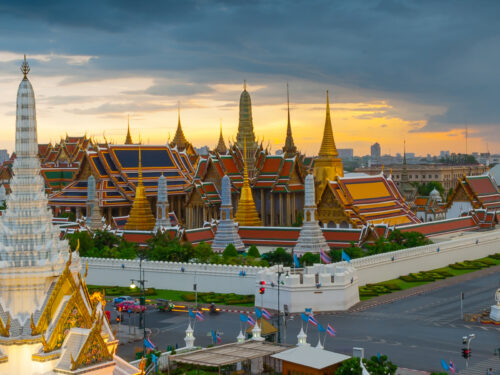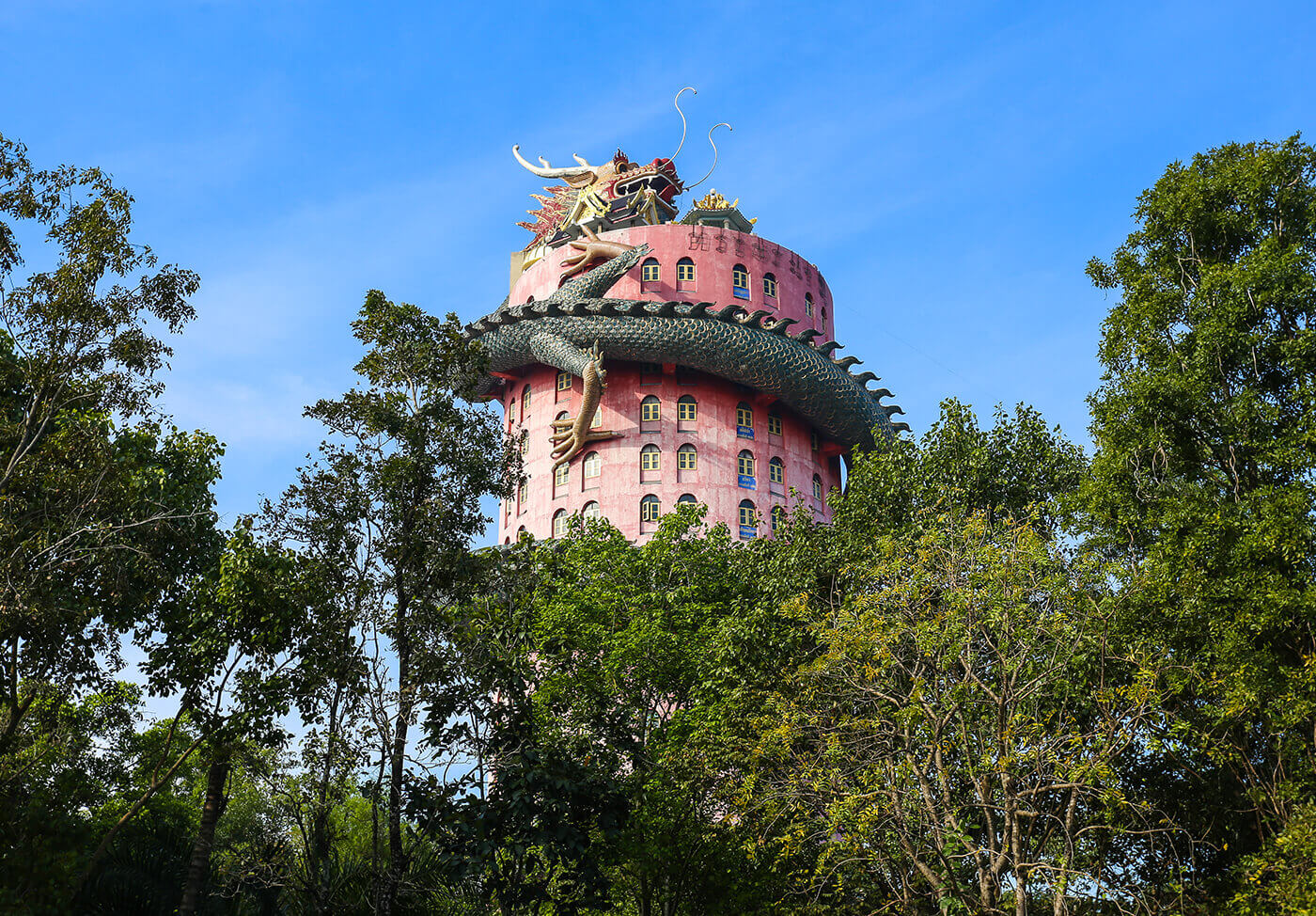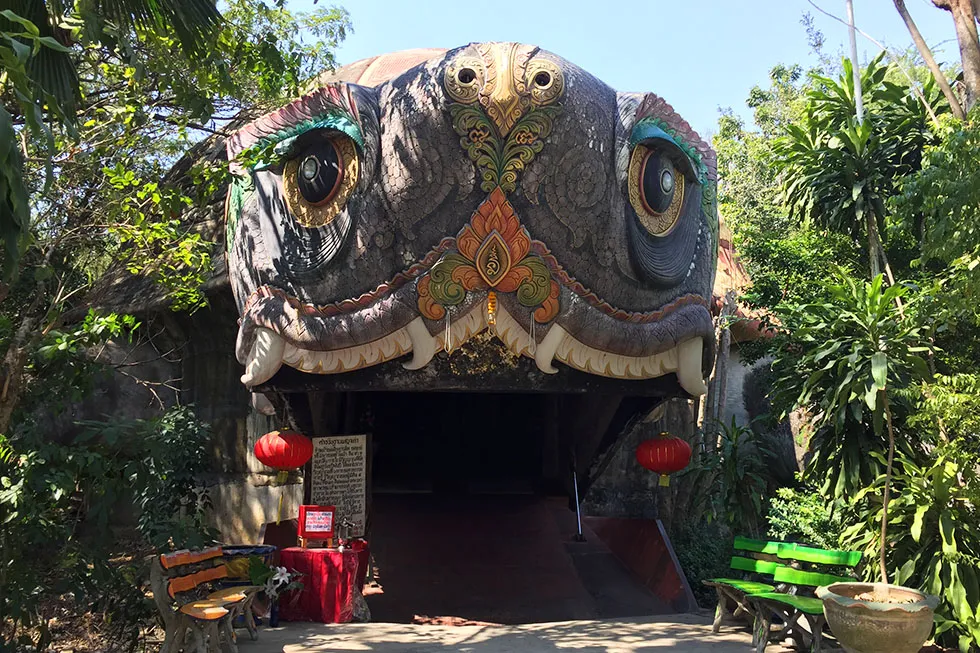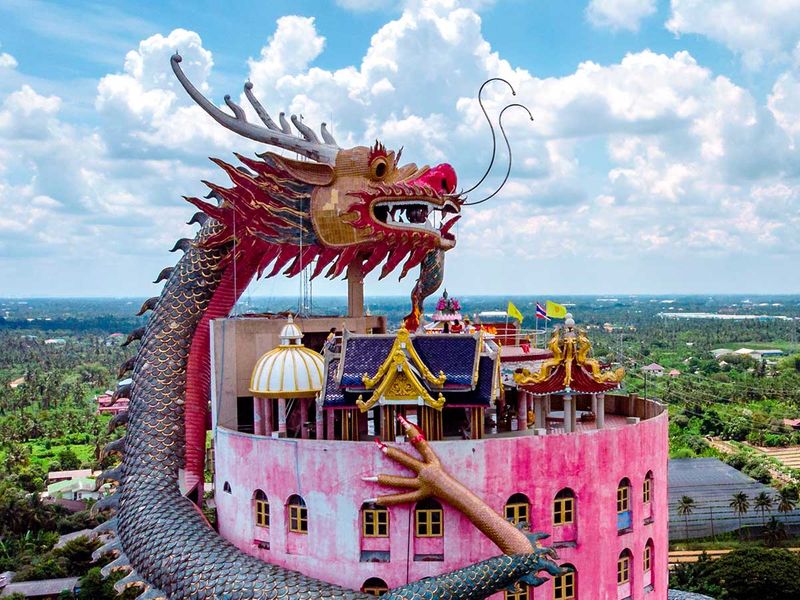Wat Samphran
If you have visited most of the famous temples such as Wat Pho, Wat Traimit, Wat Arun,… and want to find something more extraordinary, Wat Samphran is a perfect destination to come.
Just 30 miles outside of Bangkok stand Wat Samphran, also known as the “Dragon temple”. This spot isn’t very popular among foreigners since it hardly can be found in any travel guide. Therefore, visitors can take their peaceful time to stay away from the hustle of city life and the crowded tourist attractions.
1. Architecture of Wat Samphran
The Wat Samphran Temple is an unusual and mysterious building. Located in the Sam Phran District in the Nakhon Pathom province of Thailand, it is a rose-colored tower that reaches a height of 80 meters with 17 stories. The architecture of Wat Samphran and its premises has a deep significance whose origin is from several components in both Chinese and Thai mythology and beliefs.
The main tower and the dragon
The reason for its special name “Dragon Temple” is the gigantic emerald-green dragon crawling up around the tower.
The structure is 80m in height, corresponding to the Buddha’s final age. The number of the floors, 17 signifies heavenly Brahma’s realms that one reaches in the afterlife based on the level of monastic achievement and karma accumulation. Wat Samphran’s Tower of the Dragon is indeed a place of worship, but it is different from the common design standards of Thai times, which usually separates the area dedicated to Buddha and the monk’s residency.
Each detail of the tower has its meaning. For example, the dragon that surrounds the building from the bottom to the top symbolizes a human’s journey from suffering to happiness, as Buddhism believes, people are living in hell and need to find their way to serenity.
Why it is a dragon but not another type of animal? There are two stories behind this dragon image. The first one according to the local tale, the dragon depicts a strong, mighty, character like an ancient Chinese creature that is also a symbol of the emperor, the god, or the superiors.
However, according to the Thai story, Phaya Naga is a semi-divine, demi-creature, which possesses supernatural powers. They are also mentioned in several parts of the legends of Buddha’s history. After Buddha’s enlightenment, there was heavy rainfall. Noticing the problem, the great Naga coiled himself as a throne and spread his 7-pronged head, providing a hood over Buddha when he was in deep serenity under the Indian Oaktree.
Therefore, the word “Naga” is sometimes used in a Buddhist ceremony in Thailand. At the entrance of many temples, you can find these unique creatures standing as temple guards from evil.
The inside of this gigantic dragon is hollow, letting the visitor go inside and get to the two last floors on top of the building. There, visitors can witness the mighty head of this dragon. You can touch the beard of the dragon. People believe that the power of the dragon will grant you good luck if you do that. There is even a photo booth to capture the best image. The view from the top is dazzling. You can see the landscape around the tower as well as a hazy outline of Bangkok’s skyline.
Furthermore, the dragon’s five claws are said to be a symbolic reminder of the five moral precepts in Buddhism.
The surrounding of Wat Samphran
The tower with the dragon is the highlight of Wat Samphran but the surroundings of the main buildings also have some temples, beautiful monuments, and interesting statues.
There are seven small shrines in the footsteps of the main buildings. To the nuns in the temple, each shrine is worshipped on a particular day of the week. So depending on the day of the visit, you can come inside and pay respects to that particular one.
Besides the temples, there’s a lot more to see and do around Wat Samphran as there is a grand garden in the surroundings of War Samphran.
The trail is entirely decorated with hands and footprints pressed into the cement floor. Following the path, visitors will walk past all kinds of animals and objects statues, such as an undulating path with jumping dolphins, a white rabbit, statues of tigers, a huge elephant under which is a small path to walk through, and a wooden ship that suddenly appears out of nowhere. The highlight is the turtle which you can walk under through a large underground concrete tunnel with a small pond.
In conclusion, visitors can spend about an hour walking through the gardens and marveling at Wat Samphran’s sights.
2. History of Wat Samphran
The details such as when Wat Samphran was built, and who designed it are nowhere to be found.
Its origin remains a mystery as well as the date it was built we can be sure that it was officially registered in 1985. The original founder of this temple is said to have been inspired to build the temple after a seven-day meditation and fast. Construction is said to have taken only five years and the temple was meant to be a place for monks to study and meditate but was never finished due to a scandal.
Have you ever wondered why such a stunning temple like this is so unpopular among tourists? It used to have a tragic scandal related to its founder.
This story is one of the biggest scandals in Thai Buddhism.
When the monk was at the peak of his fame, he was accused of abusing 6 girls for years. These girls were from northern tribal ethnic groups and had been taken to the temple for their education. After the court, he was sentenced to 160 years in jail. Also, several nuns were convicted for helping and covering up the abbot’s sin.
Even with the sentence from the court, some of the abbot’s followers didn’t lose faith in him. They argued that he had been the victim of a plot, and continued to defend his name and show support for him.
His sentence was later commuted and on May 2021 the infamous monk was released from jail at age 72. He has been forbidden to teach Buddhism again.
Due to this scandal, some parts of the Wat were abandoned and the temple was rarely repaired. Its name is also crossed out from most travel. However, if you are interested in architecture and antiquity, you can visit this place and admire the scenery.
3. Dress code
Despite its unique architecture, Wat Samphran is still a temple. If you plan to come here, you should prepare culturally appropriate clothes.
Make sure your clothes are long enough to cover the shoulders and knees. Do not wear body-hugging, see-through, over-ripped, or revealing clothes, or you can be refused to come inside the Wat Samphran. If you are already there wearing a skirt or sleeveless blouse, you can use a scarf or a sarong to cover up.
Everyone will be asked to remove their shoes before going inside the tower or any temples. So we recommend visitors wear simple, easily-taking-off shoes.
4. Location and how to get there
Address: 92 Sam Phran, Sam Phran District, Nakhon Pathom 73110, Bangkok, Thailand
Wat Samphran is not in the center of Bangkok. Therefore, the easiest and most convenient way is to take a taxi. A taxi will cost somewhere between 300-500THB from Bangkok city to Wat Samphran one way, depending on your location in the city.
In case you have a private car, parking at the temple is available and free for everyone.
5. Tickets and other practicalities
Entrance is free but a donation of 20 Baht is requested to pay for the electricity for the elevator into the tower tunnel.
Operation hour:
Sat-Sun: 06:00 am – 06:00 pm
Mon-Fri: 09:00 am – 05:00 pm
You might also like:
Read this article in french:
Other attractions

